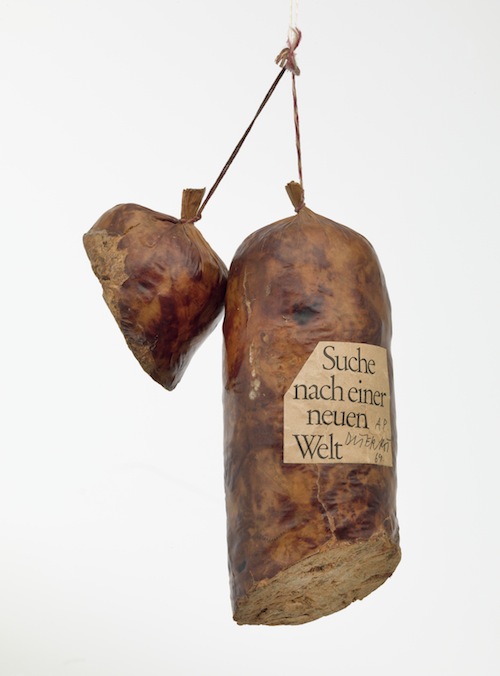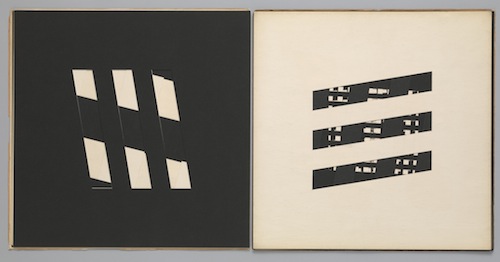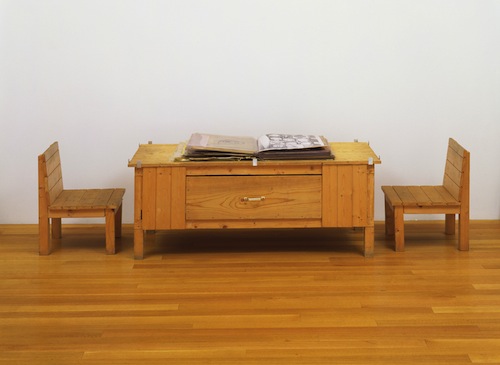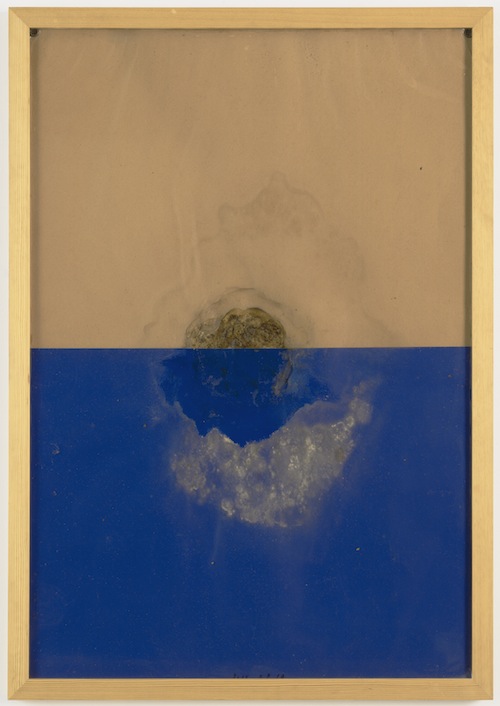
Dieter Roth, “Literature Sausage (Literaturwurst),” 1969, published 1961-70. Artist’s book of ground copy of Suche nach einer Neuen Welt by Robert F. Kennedy. Gelatin, lard, and spices in natural casing. Overall (approx.) 12 x 6 11/16 x 3 9/16 in. The Museum of Modern Art, New York. The Print Associates Fund in honor of Deborah Wye.
Dieter Roth (1930–1998) was one of the great sensualists of the twentieth century and among the era’s most important printmakers. He worked prolifically across a number of mediums and with a set of standards unlike any of his peers. Roth’s art could be equally conceptual and carnal; he saw boundaries as bridges and embraced artistic strategies others would never consider. Though he developed exceptional technical skills during his lifetime, perfection was never an end goal; a relentlessly driving enthusiasm for experimentation was the genesis of Roth’s greatest work.
Wait, Later This Will Be Nothing: Editions by Dieter Roth, on view at the Museum of Modern Art in New York, offers a thematic approach to appreciating Roth’s contribution to the field of printmaking. Organized by Sarah Suzuki, an associate curator in the department of prints and illustrated books, the exhibition breaks down into five sections and spans roughly twenty years. It begins with examples of his earliest book experiments from the late fifties and winds its way to the mid seventies when Roth began making box sets of his books and developing trolleys to carry the collection. Though there could always be more room to spread out and examine book works as expansive as Roth’s, the exhibition has left little out. All of Roth’s major print-oriented artworks are present.
Roth loved making books and was among the first to radically expand the idea of what a book could be. “I make art only to support my habit,” he once commented, “which is to write and publish books.” Though as evidenced by the work on view, Roth favored a pretty liberal definition of “writing.” With the exception of his volumes of poetry—all titled Shit—there is hardly a complete sentence to be found in two decades worth of book making, and even here there aren’t many. This doesn’t come as a surprise; right from the start Roth does his best to divorce language from meaning with a brand of concrete poetry that is nearly non-linguistic.
Executed using monotype lettersets that enabled complete typographic freedom, Bok (1956-59) is among the earliest works in the exhibition. On page after page, letters and punctuation marks are arranged in visual patterns that emphasize spatial relationships and point to an interest in the communicative power of graphic design. It is a triumph of aesthetics over linguistics, a lexicon that replaces the laws of conventional semantics with those of abstract pictorial compositions.
More radical was Roth’s unbinding of the book. Without a spine the pages remained loose and could be arranged in any manner of ways. This structural break in the book’s form translated into an increasingly kinetic experience for the viewer; the content was no longer set by the author but rather determined by the handling of the object. Instead of using typography, Roth cut shapes into cardstock further emphasizing the importance of pattern and placement. For example, in book c6 (1959) the artist sliced a number of slots into all the pages, which alternated between black and white. The slots vary in size and quantity from one page to the next, so the composition builds and shifts as pages stack up.

Dieter Rith, “book c6,” 1959. Artist’s book with sheets of handcut cardstock. Sheet (each): 15 x 15 in. The Museum of Modern Art Library.
Framed and hung in a grid pattern on the wall, Book c6 is among the first works in the exhibition and it betrays one of two central paradoxes for curators dealing with Roth. The question is whether to treat the artwork as an artifact or to recreate it in a manner that would be more in keeping with the intended experience of the artwork. Suzuki chose the anti-empirical approach and as a result viewers are treated to the original object, though it is ultimately emptied of considerable content. The pages of Book c6 are shown as if they were a series of drawings, which misleadingly draws attention to the minimalist design of each page rather than highlighting the interactive nature of the work. Other efforts at simulation include touch screen technology, but this too leaves much wanting. Scrolling from one high definition image to the next seems more like an archivist’s solution than a curatorial one.
Where these early works focused primarily on formal design elements, the second room of the exhibition draws on an entirely different aspect of Roth’s approach to book making. It calls attention to his use of mass media such as comic books, newspapers, and postcards. These raw materials become essentially illegible though still recognizable under Roth’s guidance. He uses newspaper clippings to make books the size of thumbnails, obscures postcard images by painting or printing colors directly over them, and in the instance of bok 3A, 3b and 3c (1961) simply gathers up and binds together waste material he finds laying on the print shop floor. With these works Suzuki introduces Roth’s proclivity for accumulation and his preference for unorthodox artistic strategies, two tendencies that become orienting poles for the young German as he progresses into more ambitious projects.
1960 was a big year for Roth. His unorthodox books earned him a major international prize (a first for the artist): two thousand dollars from the William and Noma Copley Foundation. The award was intended for the production of a monograph that would feature Roth’s work, but he chose to use the money to make something new instead. Over the next five years Roth compiled a vast collection of notes, doodles, scraps, letters and test prints that more than anything else documented the process of making a book. He sent all of this material piece by piece from Iceland, where he was living at the time, to his friend Richard Hamilton in London. Hamilton oversaw the production of the project, which became The Copley Book (1965). It’s Roth’s first significant unbound work and its pages are displayed here in a long shallow vitrine that allows for close scrutiny.
One of the high points of the exhibition is the opportunity to see both The Copley Book and Roth’s even more epic project, Snow (1964-1969). This later work represents the crux of the exhibition and is given the lion’s share of space in the galleries. Both books were produced during the same decade, and if The Copley Book pointed the direction Roth wanted to go, Snow announced his arrival. With pages so worked that they needed to be kept in sleeves of plastic, Snow is the unruly manifestation of Roth’s prolific practice.

Dieter Roth, “Snow,” 1964/69. Book of mixed mediums with wood table and chairs. Book (closed) 4 x 18 x 20 in. (irregular); collages, each 20 x 18 in.; commode 22 5/8 x 58 3/4 x 25 7/8 in.; chairs, each 24 1/8 x 17 3/4 x 18 1/2 in. The Museum of Modern Art, New York. Committee on Painting and Sculpture Funds.
In addition to a selection of the book’s pages spread across two walls, a customized reading desk Roth designed for the work sits on a raised platform and a collection of paraphernalia relating to Snow’s genesis is on view under glass. The desk looks terribly uncomfortable, though it foreshadows Roth’s fascination with vessels of containment, which will be the focus of the final section of the exhibition. The paraphernalia—an exhibition announcement, letters, and a paperback edition—contextualizes the artwork within a historical narrative that the book itself does not make available. It provides a glimpse into the five-year gestation period during which the artist persevered despite losing support for the project multiple times.
Many of the formal strategies Roth used to make The Copley Book are observable in Snow. Pages are held together with staples, glue, old tape, and paperclips; many are folded or torn and reattached at another angle. On the whole the book seems to present a compendium of artistic methodologies; one page shows “how to make a reverse Duchamp,” another “how to make a portrait of Natalie.” There are mathematical notations that read like linguistic games and notes on the artist’s experimental printing methods, such as the “faints” he produced from plates that have had their ink mostly removed. Perhaps the most fascinating and literal connection between The Copley Book and Snow is the appearance of a collaged page featuring a light bulb—a visual motif of Snow—with the inscription “Man and shadow.” In The Copley Book there is a famous letter from Roth’s printer describing a page he lost that bore the same caption. Finding this lost page in Snow enhances the sense of continuity between these works and exemplifies the artist’s penchant for recycling and reusing his own material.
Though there is little to chuckle over in these powerful works, Roth had a rich sense of humor and was especially fond of puns and wordplay. He developed a fascination with the process of decomposition at least partially because his surname can be pronounced like the word “rot.” One of his means of actualizing this process was to incorporate foodstuffs—cheese, chocolate, sausage, capers, licorice, and vegetable juice—in his printing practice. On view in the third gallery, these pieces propose another paradoxical situation for curators: how does one conserve something meant to decay? This question is smartly taken up by three conservators in a set of essays in the exhibition’s catalogue. Though they do a fine job characterizing the physical demands of the situation, the more conceptual issues are left unattended too. By taking great pains at preservation, Roth’s admonition scrawled on a page in Snow and adopted for the exhibition’s title, “Wait, later this will be nothing,” is made into a thematically relevant rhetorical statement; it’s currency as a controversial statement is diminished. Thankfully for contemporary viewers, even non-archival materials can be preserved.
To this end, warped and molding material is a constant characteristic of Roth’s food prints. In one instance a bluish fungus spreads across a lithograph of a street scene, supplying a sickening foliage to the trees. For Big Sunset (1968) the artist pressed a disc of sausage on cardstock. The lower half of the cardstock is blue, the upper half is brown and the sausage is centered on the horizon, as if it were the sun going down. There are no axial light spikes or watery reflections; instead the corona around Roth’s meat sun is a splotchy grease stain. The most amusing work in this vein may be Roth’s Literaturwursts (1961-70), which are traditional German sausages made with literature. He considered these as artist books and prepared them just as a chef would an edible sausage, with gelatin, lard, and spices packed in either synthetic or natural casing, except Roth replaced the meat with shreds of prose from books by Goethe, Marx, Hegel, and Gunther Grass.

Dieter Roth, “Big Sunset (Grosser Sonnenuntergang),” 1968, published 1970. Sausage on cardstock in plastic cover. Composition and sheet: 37 3/8 x 25 9/16 in. The Museum of Modern Art, New York. Riva Castleman Endowment Fund and
Alexandra Herzan Fund.
Roth maintained complex relationships with his peers, many of whom he admired and envied in equal measure. In her catalogue essay, Suzuki does a tremendous job describing the affect Roth’s friends had on his art and life. She shows how Duchamp helped Roth secure the Copley Award (he sat on the jury for the prize), and how both artists embraced the accidental in their work. She illustrates Roth’s often cantankerous attitude with a hilarious story about the time he wrecked one of Beuys’s sculptures out of sheer anger, after Beuys had essentially gotten the broke artist a teaching gig. Suzuki’s text also does a great job situating Roth within a particularly avant-garde social milieu, which more than adequately contextualizes the work in the exhibition.
The work in the last gallery is mostly from the seventies and it represents a clear and logical end point of the exhibition. Focused on vessels of containment, objects such as trollies, cabinets, and cubes become increasingly regular. The various book projects spread throughout the previous galleries appear again in condensed paperback form, like a box set. In The Collected Works, Vol 1-20, (1969-79) it is as if the artist’s inclination for accumulation has risen to a meta level. He amasses collections of his earlier artworks and presents the agglomeration as something new. However, The Collected Works also represents an effort that would appear to contradict the artist’s predilection for processes of decay. Like the team of curators and conservators that made this exhibition possible, Dieter Roth was clearly interested in preserving work that he knew might otherwise have a limited shelf life.
______
Charles Schultz is a guest writer filling in for Sarah Kirk Hanley who returns next month. Schultz is a New York–based art critic who has written about art since moving to New York in 2007. He currently contributes to the Brooklyn Rail, Modern Painters, Art in America, and Artslant.



